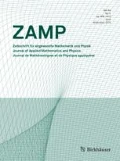Abstract
Using a balance law for microforces and an appropriate statement of the second law of thermodynamics, a framework is provided for continuum theories that involve a microstructural variable. Examples of specific physical theories that fall within that framework—spanning internal state-variable theories for plasticity and polymeric solutions, order-parameter based theories for phase transitions, and various theories for liquid crystals-are given.
References
A. Gordon and J. Genossar,Precursor order clusters at ferroelectric phase transitions, Physica B125, 53–62 (1984).
J. L. Ericksen,Liquid crystals with variable degree of orientation, Arch. Rat. Mech. Analysis113, 97–120 (1991).
B. D. Coleman and W. Noll,The thermodynamics of elastic materials with heat conduction and viscosity, Arch. Rat. Mech. Analysis13, 167–178 (1963).
M. E. Gurtin and P. W. Voorhees,The continuum mechanics of coherent two-phase elastic solids with mass transport, Proc. Roy. Soc, London A 440, 323–343 (1993).
B. D. Coleman and M. E. Gurtin,Thermodynamics with internal state variables, J. Chem. Phys.47, 597–613 (1967).
J. Kratochvil and O. W. Dillon,Thermodynamics of elastic-plastic materials as a theory of internal state variables, J. Appl. Phys.40, 3207–3218 (1969).
J. Lubliner,On fading memory in materials of evolutionary type, Acta Mech.8, 75–78 (1969).
J. R. Rice,Inelastic constitutive relations for solids: an internal-variable theory and its application to metal plasticity. J. Mech. Phys. Solids19, 433–455 (1971).
G. L. Hand,A theory of anisotropic fluids, J. Fluid Mech.13, 33–46 (1962).
P. A. Dashner and W. E. Varnarsdale,A phenomenological theory for elastic fluids, J. Non-Newtonian Fluid Mech.8, 59–67 (1981).
G. A. Maughin and R. Drouot,Internal variables and the thermodynamics of macromolecule solutions, Int. J. Eng. Sci.21, 705–724 (1983).
Th. de Donder and P. van Rysselberghe,Thermodynamic Theory of Affinity, Oxford University Press, London 1936.
S.-K. Chan,Steady-state kinetics of diffusionless first order phase transformations, J. Chem. Phys.67, 5755–5762 (1977).
S. M. Alien and J. W. Cahn,A macroscopic theory for antiphase boundary motion and its application to antiphase domain coarsening, Acta Metall. 27, 1085–1095 (1979).
E. Fried and M. E. Gurtin,Continuum theory of thermally induced phase transitions based on an order parameter, Physics D68, 326–343 (1993).
E. Fried and M. E. Gurtin,Dynamic solid-solid transitions with phase characterized by an order parameter, Physica D72, 287–308 (1994).
M. E. Gurtin, D. A. Polignone and J. Viñals,Two-phase binary fluids and immiscible fluids described by an order parameter, Math. Models Methods Appl. Sci., to appear.
E. G. Virga,Defects in nematic liquid crystals with variable degree of orientation, in:Nematics (Eds. J.-M. Coron, J.-M. Ghidaglia and F. Hélein), Kluwer Academic Publ., Dordrecht 1991.
P. G. de Gennes.Short range order effects in the isotropic phase of nematics and cholesterics, Mol. Cryst. Liquid Cryst.12, 193–214 (1971).
Author information
Authors and Affiliations
Rights and permissions
About this article
Cite this article
Fried, E. Continua described by a microstructural field. Z. angew. Math. Phys. 47, 168–175 (1996). https://doi.org/10.1007/BF00917581
Received:
Revised:
Issue Date:
DOI: https://doi.org/10.1007/BF00917581

